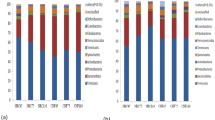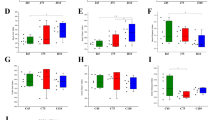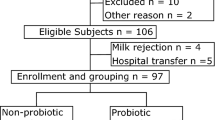Abstract
Intrauterine growth restriction (IUGR) predisposes newborns to inflammatory and metabolic disturbance. Disequilibrium of gut microbiota in early life has been implicated in the incidence of inflammation and metabolic diseases in adulthood. This study aimed to investigate the difference in gut microbiota colonization, cytokines and plasma metabolome between IUGR and normal birth weight (NBW) piglets in early life. At birth, reduced (P < 0.05) body, jejunum, and ileum weights, as well as decreased (P < 0.05) small intestinal villi and increased (P < 0.05) ileal crypt depth were observed in IUGR piglets compared with their NBW counterparts. Imbalanced inflammatory and plasma metabolome profile was observed in IUGR piglets. Furthermore, altered metabolites were mainly involved in fatty acid metabolism and inflammatory response. At 12 h after birth and after suckling colostrum, reduced (P < 0.05) postnatal growth and the small intestinal maturation retardation (P < 0.05) continued in IUGR piglets in comparison with those in NBW littermates. Besides, the gut microbiota structure was significantly altered by IUGR. Importantly, the disruption of the inflammatory profile and metabolic status mainly involved the pro-inflammatory cytokines (IL-1β and IFN-γ) and amino acid metabolism. Moreover, spearman correlation analysis showed that the increased abundance of Escherichia-Shigella and decreased abundance of Clostridium_sensu_stricto_1 in IUGR piglets was closely associated with the alterations of slaughter weight, intestinal morphology, inflammatory cytokines, and plasma metabolites. Collectively, IUGR significantly impairs small intestine structure, modifies gut microbiota colonization, and disturbs inflammatory and metabolic profiles during the first 12 h after birth. The unbalanced gut microbiota mediated by IUGR contributes to the development of inflammation and metabolic diseases.
Similar content being viewed by others
References
Abrams, G.D., Bauer, H., and Sprinz, H. 1963. Influence of the normal flora on mucosal morphology and cellular renewal in the ileum. A comparison of germ-free and conventional mice. Lab. Invest. 12, 355–364.
Amu, S., Hahn-Zoric, M., Malik, A., Ashraf, R., Zaman, S., Kjellmer, I., Hagberg, H., Padyukov, L., and Hanson, L.Å. 2006. Cytokines in the placenta of Pakistani newborns with and without intrauterine growth retardation. Pediatr. Res. 59, 254–258.
Ardissone, A.N., de la Cruz, D.M., Davis-Richardson, A.G., Rechcigl, K.T., Li, N., Drew, J.C., Murgas-Torrazza, R., Sharma, R., Hudak, M.L., Triplett, E.W., et al. 2014. Meconium microbiome analysis identifies bacteria correlated with premature birth. PLoS One 9, e90784.
Arrieta, M.C., Stiemsma, L.T., Amenyogbe, N., Brown, E.M., and Finlay, B. 2014. The intestinal microbiome in early life: health and disease. Front. Immunol. 5, 427.
Aw, T.Y. 2005. Intestinal glutathione: determinant of mucosal peroxide transport, metabolism, and oxidative susceptibility. Toxicol. Appl. Pharmacol. 204, 320–328.
Benjamini, Y. and Hochberg, Y. 1995. Controlling the false discovery rate — a practical and powerful approach to multiple testing. J. Roy. Stat. Soc. Ser. B Met. 57, 289–300.
Bouskra, D., Brézillon, C., Berard, M., Werts, C., Varona, R., Boneca, I.G., and Eberl, G. 2008. Lymphoid tissue genesis induced by commensals through NOD1 regulates intestinal homeostasis. Nature 456, 507–510.
Briana, D.D., Liosi, S., Gourgiotis, D., Boutsikou, M., Marmarinos, A., Baka, S., Hassiakos, D., and Malamitsi-Puchner, A. 2012. Fetal concentrations of the growth factors TGF-α and TGF-β1 in relation to normal and restricted fetal growth at term. Cytokine 60, 157–161.
Cao, J., Li, M., Chen, J., Liu, P., and Li, Z. 2016. Effects of MeJA on Arabidopsis metabolome under endogenous JA deficiency. Sci. Rep. 6, 37674.
Castanys-Muñoz, E., Martin, M.J., and Vazquez, E. 2016. Building a beneficial microbiome from birth. Adv. Nutr. 7, 323–330.
Chong, J., Soufan, O., Li, C., Caraus, I., Li, S., Bourque, G., Wishart, D.S., and Xia, J. 2018. MetaboAnalyst 4.0: towards more transparent and integrative metabolomics analysis. Nucleic Acids Res. 46, W486–W494.
D’Inca, R., Kloareg, M., Gras-Le Guen, C., and Le Huërou-Luron, I. 2010. Intrauterine growth restriction modifies the developmental pattern of intestinal structure, transcriptomic profile, and bacterial colonization in neonatal pigs. J. Nutr. 140, 925–931.
Desir-Vigne, A., Haure-Mirande, V., de Coppet, P., Darmaun, D., Le Drean, G., and Segain, J.P. 2018. Perinatal supplementation of 4-phenylbutyrate and glutamine attenuates endoplasmic reticulum stress and improves colonic epithelial barrier function in rats born with intrauterine growth restriction. J. Nutr. Biochem. 55, 104–112.
Dessi, A., Ottonello, G., and Fanos, V. 2012. Physiopathology of intrauterine growth retardation: from classic data to metabolomics. J. Matern. Fetal Neonatal Med. 25, 13–18.
Drago, L., Toscano, M., Rodighiero, V., De Vecchi, E., and Mogna, G. 2012. Cultivable and pyrosequenced fecal microflora in centenarians and young subjects. J. Clin. Gastroenterol. 46 Suppl, S81–84.
Escobedo, G., López-Ortiz, E., and Torres-Castro, I. 2014. Gut microbiota as a key player in triggering obesity, systemic inflammation and insulin resistance. Rev. Invest. Clin. 66, 450–459.
Fanca-Berthon, P., Hoebler, C., Mouzet, E., David, A., and Michel, C. 2010. Intrauterine growth restriction not only modifies the cecocolonic microbiota in neonatal rats but also affects its activity in young adult rats. J. Pediatr. Gastroenterol. Nutr. 51, 402–413.
Ferenc, K., Pietrzak, P., Godlewski, M.M., Piwowarski, J., Kilianczyk, R., Guilloteau, P., and Zabielski, R. 2014. Intrauterine growth retarded piglet as a model for humans-studies on the perinatal development of the gut structure and function. Reprod. Biol. 14, 51–60.
Foxx-Orenstein, A.E. and Chey, W.D. 2012. Manipulation of the gut microbiota as a novel treatment strategy for gastrointestinal disorders. Am. J. Gastroenterol. Suppl. 1, 41–46.
Gibson, G.R., Probert, H.M., Loo, J.V., Rastall, R.A., and Roberfroid, M.B. 2004. Dietary modulation of the human colonic microbiota: updating the concept of prebiotics. Nutr. Res. Rev. 17, 259–275.
Giogha, C., Lung, T.W., Pearson, J.S., and Hartland, E.L. 2014. Inhibition of death receptor signaling by bacterial gut pathogens. Cytokine Growth Factor Rev. 25, 235–243.
Hong, X., Chen, J., Liu, L., Wu, H., Tan, H., Xie, G., Xu, Q., Zou, H., Yu, W., Wang, L., et al. 2016. Metagenomic sequencing reveals the relationship between microbiota composition and quality of Chinese rice wine. Sci. Rep. 6, 26621.
Houghteling, P.D. and Walker, W.A. 2015. Why is initial bacterial colonization of the intestine important to infants’ and children’s health? J. Pediatr. Gastroenterol. Nutr. 60, 294–307.
Hu, L., Liu, Y., Yan, C., Peng, X., Xu, Q., Xuan, Y., Han, F., Tian, G., Fang, Z., Lin, Y., et al. 2015. Postnatal nutritional restriction affects growth and immune function of piglets with intra-uterine growth restriction. Br. J. Nutr. 114, 53–62.
Hu, L., Peng, X., Chen, H., Yan, C., Liu, Y., Xu, Q., Fang, Z., Lin, Y., Xu, S., Feng, B., et al. 2017. Effects of intrauterine growth retardation and Bacillus subtilis PB6 supplementation on growth performance, intestinal development and immune function of piglets during the suckling period. Eur. J. Nutr. 56, 1753–1765.
Kelly, D. and Coutts, A.G. 2000. Early nutrition and the development of immune function in the neonate. Proc. Nutr. Soc. 59, 177–185.
Kundu, P., Blacher, E., Elinav, E., and Pettersson, S. 2017. Our gut microbiome: The evolving inner self. Cell 171, 1481–1493.
Le Drean, G., Haure-Mirande, V., Ferrier, L., Bonnet, C., Hulin, P., de Coppet, P., and Segain, J.P. 2014. Visceral adipose tissue and leptin increase colonic epithelial tight junction permeability via a RhoA-ROCK-dependent pathway. FASEB J. 28, 1059–1070.
Li, N., Huang, S., Jiang, L., Wang, W., Li, T., Zuo, B., Li, Z., and Wang, J. 2018. Differences in the gut microbiota establishment and metabolome characteristics between low- and normal-birth-weight piglets during early-life. Front. Microbiol. 9, 1798.
Li, N., Wang, W., Wu, G., and Wang, J. 2017. Nutritional support for low birth weight infants: insights from animal studies. Br. J. Nutr. 117, 1390–1402.
Lin, G., Wang, X., Wu, G., Feng, C., Zhou, H., Li, D., and Wang, J. 2014. Improving amino acid nutrition to prevent intrauterine growth restriction in mammals. Amino Acids 46, 1605–1623.
Loh, K.R., Shrader, R.E., and Zeman, F.J. 1971. Effect of maternal protein deprivation on neonatal intestinal absorption in rats. J. Nutr. 101, 1663–1671.
Longo, S., Bollani, L., Decembrino, L., Di Comite, A., Angelini, M., and Stronati, M. 2013. Short-term and long-term sequelae in intrauterine growth retardation (IUGR). J. Matern. Fetal Neonatal Med. 26, 222–225.
Lopetuso, L.R., Scaldaferri, F., Petito, V., and Gasbarrini, A. 2013. Commensal Clostridia: leading players in the maintenance of gut homeostasis. Gut Pathog. 5, 23.
Madan, J.C., Salari, R.C., Saxena, D., Davidson, L., O’Toole, G.A., Moore, J.H., Sogin, M.L., Foster, J.A., Edwards, W.H., Palumbo, P., et al. 2012. Gut microbial colonisation in premature neonates predicts neonatal sepsis. Arch. Dis. Child. Fetal Neonatal Ed. 97, F456–F462.
Masella, A.P., Bartram, A.K., Truszkowski, J.M., Brown, D.G., and Neufeld, J.D. 2012. PANDAseq: paired-end assembler for illumina sequences. BMC Bioinformatics 13, 31.
McElrath, T.F., Allred, E.N., Van Marter, L., Fichorova, R.N., Leviton, A., and ELGAN Study Investigators. 2013. Perinatal systemic inflammatory responses of growth-restricted preterm newborns. Acta Paediatr. 102, e439–e442.
McIntire, D.D., Bloom, S.L., Casey, B.M., and Leveno, K.J. 1999. Birth weight in relation to morbidity and mortality among newborn infants. N. Engl. J. Med. 340, 1234–1238.
Osborn, O. and Olefsky, J.M. 2012. The cellular and signaling networks linking the immune system and metabolism in disease. Nat. Med. 18, 363–374.
Pallotto, E.K. and Kilbride, H.W. 2006. Perinatal outcome and later implications of intrauterine growth restriction. Clin. Obstet. Gynecol. 49, 257–269.
Qiu, X.S., Huang, T.T., Shen, Z.Y., Deng, H.Y., and Ke, Z.Y. 2005. Effect of early nutrition on intestine development of intrauterine growth retardation in rats and its correlation to leptin. World J. Gastroenterol. 11, 4419–4422.
Rogers, L.K. and Velten, M. 2011. Maternal inflammation, growth retardation, and preterm birth: Insights into adult cardiovascular disease. Life Sci. 89, 417–421.
Rowland, I., Gibson, G., Heinken, A., Scott, K., Swann, J., Thiele, I., and Tuohy, K. 2018. Gut microbiota functions: metabolism of nutrients and other food components. Eur. J. Nutr. 57, 1–24.
Saavedra, J.M. and Dattilo, A.M. 2012. Early development of intestinal microbiota: implications for future health. Gastroenterol. Clin. North Am. 41, 717–731.
Salam, R.A., Das, J.K., and Bhutta, Z.A. 2014. Impact of intrauterine growth restriction on long-term health. Curr. Opin. Clin. Nutr. Metab. Care 17, 249–254.
Stecher, B. 2015. The roles of inflammation, nutrient availability and the commensal microbiota in enteric pathogen infection, pp. 297–320. In Metabolism and bacterial pathogenesis. American Society of Microbiology.
Turnbaugh, P.J., Hamady, M., Yatsunenko, T., Cantarel, B.L., Duncan, A., Ley, R.E., Sogin, M.L., Jones, W.J., Roe, B.A., Affourtit, J.P., et al. 2009. A core gut microbiome in obese and lean twins. Nature 457, 480–484.
Wang, W., Degroote, J., Van Ginneken, C., Van Poucke, M., Vergauwen, H., Dam, T.M.T., Vanrompay, D., Peelman, L.J., De Smet, S., and Michiels, J. 2016. Intrauterine growth restriction in neonatal piglets affects small intestinal mucosal permeability and mRNA expression of redox-sensitive genes. FASEB J. 30, 863–873.
Wang, T., Huo, Y.J., Shi, F., Xu, R.J., and Hutz, R.J. 2005. Effects of intrauterine growth retardation on development of the gastrointestinal tract in neonatal pigs. Biol. Neonate 88, 66–72.
Wang, X., Wu, W., Lin, G., Li, D., Wu, G., and Wang, J. 2010. Temporal proteomic analysis reveals continuous impairment of intestinal development in neonatal piglets with intrauterine growth restriction. J. Proteome Res. 9, 924–935.
Wang, Y., Zhang, L., Zhou, G., Liao, Z., Ahmad, H., Liu, W., and Wang, T. 2012. Dietary L-arginine supplementation improves the intestinal development through increasing mucosal Akt and mammalian target of rapamycin signals in intra-uterine growth retarded piglets. Br. J. Nutr. 108, 1371–1381.
Wang, X., Zhu, Y., Feng, C., Lin, G., Wu, G., Li, D., and Wang, J. 2018. Innate differences and colostrum-induced alterations of jejunal mucosal proteins in piglets with intra-uterine growth restriction. Br. J. Nutr. 119, 734–747.
Wu, G. 1998. Intestinal mucosal amino acid catabolism. J. Nutr. 128, 1249–1252.
Wu, G., Bazer, F.W., Wallace, J.M., and Spencer, T.E. 2006. Board-invited review: intrauterine growth retardation: implications for the animal sciences. J. Anim. Sci. 84, 2316–2337.
Yi, D., Li, B., Hou, Y., Wang, L., Zhao, D., Chen, H., Wu, T., Zhou, Y., Ding, B., and Wu, G. 2018. Dietary supplementation with an amino acid blend enhances intestinal function in piglets. Amino Acids 50, 1089–1100.
Ying, Z., Zhang, H., Su, W., Zhou, L., Wang, F., Li, Y., Zhang, L., and Wang, T. 2017. Dietary methionine restriction alleviates hyperglycemia in pigs with intrauterine growth restriction by enhancing hepatic protein kinase B signaling and glycogen synthesis. J. Nutr. 147, 1892–1899.
Zhang, L.L., Zhang, H., Li, Y., and Wang, T. 2017. Effects of medium-chain triglycerides on intestinal morphology and energy metabolism of intrauterine growth retarded weanling piglets. Arch. Anim. Nutr. 71, 231–245.
Zhang, H., Zhao, F., Peng, A., Dong, L., Wang, M., Yu, L., Loor, J.J., and Wang, H. 2018. Effects of dietary L-arginine and N-carbamylglutamate supplementation on intestinal integrity, immune function, and oxidative status in intrauterine-growth-retarded suckling lambs. J. Agric. Food Chem. 66, 4145–4154.
Zhong, X., Wang, T., Zhang, X., and Li, W. 2010. Heat shock protein 70 is upregulated in the intestine of intrauterine growth retardation piglets. Cell Stress Chaperones 15, 335–342.
Zhu, Y., Li, T., Huang, S., Wang, W., Dai, Z., Feng, C., Wu, G., and Wang, J. 2018. Maternal L-glutamine supplementation during late gestation alleviates intrauterine growth restriction-induced intestinal dysfunction in piglets. Amino Acids 50, 1289–1299.
Zhu, Y., Wang, W., Yuan, T., Fu, L., Zhou, L., Lin, G., Zhao, S., Zhou, H., Wu, G., and Wang, J. 2017. MicroRNA-29a mediates the impairment of intestinal epithelial integrity induced by intrauterine growth restriction in pig. Am. J. Physiol. Gastrointest. Liver Physiol. 312, G434–G442.
Acknowledgements
We thank the Mianyang New-hope Livestock Farming Co. Ltd in Sichuan province, China, for the assistance in this study. This work was supported by the National Natural Science Foundation of China (31630074), the Beijing Municipal Natural Science Foundation (S170001), the National Key Research and Development Program of China (2016YFD-0500506 and 2018YDF0501002), the 111 Project (B16044), Jinxinnong Animal Science Developmental Foundation and Hunan Co-Innovation Center of Animal Production Safety, CICAPS.
Author information
Authors and Affiliations
Corresponding author
Additional information
Conflict of Interest
The authors declare that the research was conducted in the absence of any commercial or financial relationships that could be construed as a potential conflict of interest.
Supplemental material for this article may be found at http://www.springerlink.com/content/120956.
Electronic supplementary material
Rights and permissions
About this article
Cite this article
Huang, S., Li, N., Liu, C. et al. Characteristics of the gut microbiota colonization, inflammatory profile, and plasma metabolome in intrauterine growth restricted piglets during the first 12 hours after birth. J Microbiol. 57, 748–758 (2019). https://doi.org/10.1007/s12275-019-8690-x
Received:
Revised:
Accepted:
Published:
Issue Date:
DOI: https://doi.org/10.1007/s12275-019-8690-x




